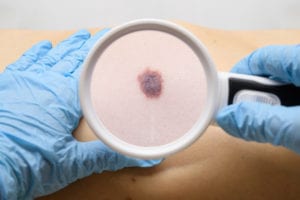Brooke Shields Talks Skin Cancer
- Posted on: Jul 15 2021
 Actor Brooke Shields has had quite the year. Not only did the 55-year-old suffer a broken femur in a freak accident using a balance board, but she was also told by her doctor that her skin held the signs of sun damage. These were not cosmetic concerns, they were spots that indicated a higher potential for skin cancer. Here, we discuss what the actor learned about her diagnosis of Solar Keratosis and what you can do to protect yourself.
Actor Brooke Shields has had quite the year. Not only did the 55-year-old suffer a broken femur in a freak accident using a balance board, but she was also told by her doctor that her skin held the signs of sun damage. These were not cosmetic concerns, they were spots that indicated a higher potential for skin cancer. Here, we discuss what the actor learned about her diagnosis of Solar Keratosis and what you can do to protect yourself.
Solar Keratosis is also known as Actinic Keratosis. This diagnosis means that some skin cells have begun to grow abnormally, indicating that they may develop into skin cancer. In the case of Shields, a doctor had to remove abnormal cells from the actor’s lips twice, once to observe superficial cells and another time to look at the deeper layers of skin. Like many middle-aged adults, Shields grew up in the era of tanning. Many in her generation hit the beach with a bottle of Baby Oil mixed with iodine in hopes of getting a golden glow. The problem with this habit is that the golden glow, unbeknownst to the tanner, is a sign of damage. Thirty to forty years later, that damage shows up on the epidermis as new brown spots, changing moles, rough skin and other conditions.
More about Actinic Keratosis
In her interview about her diagnosis, Shields reported that she is now an avid sunscreen-user. It is never too late to prevent more sun damage. However, more is often needed to address that which has already occurred. Actinic Keratoses often present as small scaly, dry, or crusty patches on the skin. They may be flesh-colored, pink, white, tan, or red. Sometimes, they are raised. One of the ways to spot these precancerous growths is to feel the roughness of the skin. Another way to discern that a growth may be abnormal is to observe where it is on the body. Actinic Keratosis usually develops in areas where the skin has been repeatedly exposed to UV light, such as the arms, ears, and face. As we see in the case of Brooke Shields, abnormal cells can even start to grow on the lips. This is referred to as actinic cheilitis.
Should You be Concerned about Actinic Keratosis?
Actinic Keratosis is not skin cancer, so why would a doctor want to remove such a growth? Because, though a relatively small percentage of these lesions turn into skin cancer, the vast majority of squamous cell carcinomas begin as AK growths. All Actinic Keratoses are indicative of sun damage and those that do worsen to squamous cell carcinoma can, without proper care, be life-threatening.
The role of the American Society for Mohs Surgery is to provide support for board-certified Mohs Specialists and also assist patients with their search for a qualified Mohs surgeon in their area. For more information on membership, contact us at (800) 616-2767. To find a doctor in your area, visit our Member Directory.
Posted in: Skin Cancer


